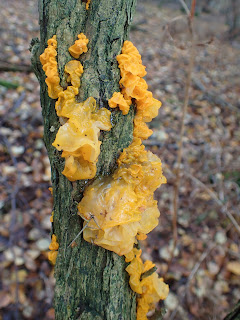16th November 2019
On Saturday I attended the last full-length study group fungus foray of the year at Crostwight Heath in north-east Norfolk. My dad grew up in the area so I used to visit as a child, but a look through my records showed I'd not visited the heath since 2011, when I got nice views of some basking Grass Snakes.
With little adjacent parking it had been arranged for us to park in a nearby farmyard. Whilst we were getting ready to walk down to the heath two skeins of Pink-footed Geese flew past, a reminder that we were quite close to the coast. Walking along the lane we arrived at the edge of some woodland, and immediately began to find quite a lot of fungi on a steep bank, including lots of Hare's Ear and some Tricholoma spp. One of these turned out to be Chemical Knight, but the other one which was identified in the field was Yellowing Knight, a new species for me.
Heading up onto the heath we walked past a large area of Slender Clubs and a couple of Powdery Brittlegills. Amongst the range of species seen Yellow Brain stood out, because although it is a common species there were large patches of it along the mature Gorse stems. A mystery Stropharia was identified later as Stropharia inuncta, my second new species of the day. Out on the open heath there was an old bonfire site on which was growing Bonfire Scalycap and a cup fungus, Peziza granulosa. The latter actually isn't one of the specific bonfire-site fungi, but was still another new species for me. We stopped for lunch and a Lesser Redpoll flew over calling.
Rather than push on across some quite similar heathland we decided to go back along the edge of the site and spend a bit of time in the woodland opposite. Species seen along the edge included Scurfy Deceiver, Blushers, Bleeding Oak Crust and a nice display of Clustered Bonnets on an old log.
Across the road a Dog Stinkhorn was of interest, and Stewart managed to find the leaf mine of Virgin Pigmy (Ectoedemia argyropeza) in an Aspen leaf, the first record for this block of 10km squares. Another excellent find by Stewart was a small black weevil covered in a fungus. Even better he managed to identify the fungus, Beauveria bassiana. The final find of the day was spectacular, probably double the size of the last one I saw - it was Leafy Brain fungus.
We walked back to the cars (seeing a Muntjac browsing in a meadow on the way), but before going had a look at a heap of decomposing straw. There wasn't a lot of fungi on it, but someone did point out some old Grass Snake eggs - good to see that years after my last visit they are still going strong.















No comments:
Post a Comment